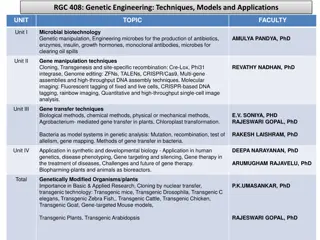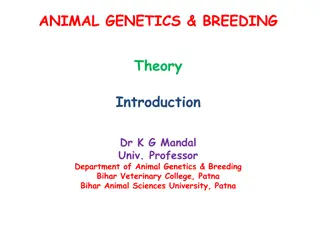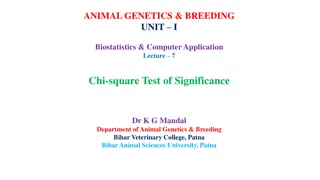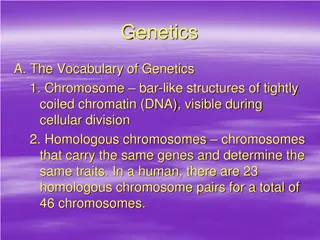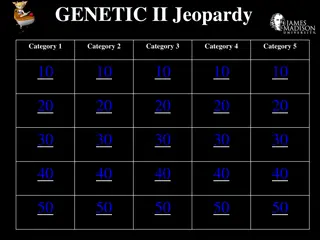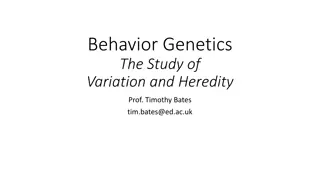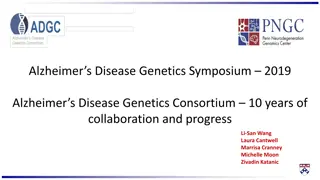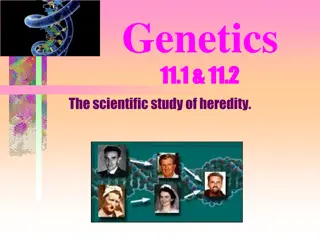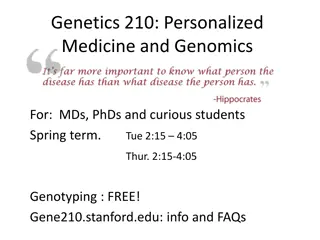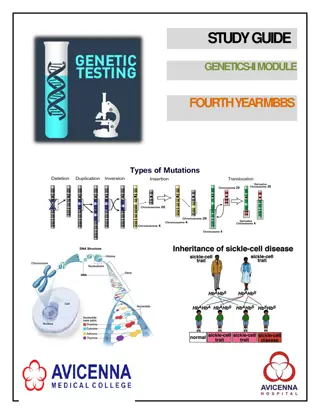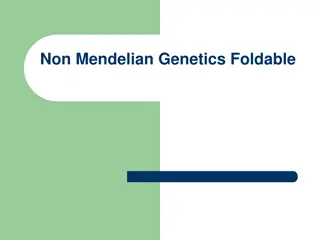GENETICS
Delve into the realm of genetics and discover the fascinating world of heredity, traits, and DNA. Explore the intricate mechanisms behind genetic inheritance and the impact it has on all living organisms. With advancements in technology and research, genetic studies continue to unravel new insights that shape our understanding of evolution and biodiversity. Whether you are a student, researcher, or simply curious about the science of genetics, this field offers a wealth of knowledge waiting to be discovered.
Download Presentation

Please find below an Image/Link to download the presentation.
The content on the website is provided AS IS for your information and personal use only. It may not be sold, licensed, or shared on other websites without obtaining consent from the author.If you encounter any issues during the download, it is possible that the publisher has removed the file from their server.
You are allowed to download the files provided on this website for personal or commercial use, subject to the condition that they are used lawfully. All files are the property of their respective owners.
The content on the website is provided AS IS for your information and personal use only. It may not be sold, licensed, or shared on other websites without obtaining consent from the author.
E N D
Presentation Transcript
CORE COURSE III GENETICS UNIT - I Classical genetics: Mendels law - Gene interaction: Co dominance, Supplementary, Complementary, Dominant Epistasis, Pleiotrophism, Penetrance, Expressivity - Sex linked Inheritance in man, Sex influenced genes, Sex limited genes - Genomic imprinting, X inactivation in mammals .
Genetics is the science of heredity. It deals with the study of charaters and their transmission from the parents to the youngones. Heredity refers to passing of physical and mental characteristics from parents to children. John Gregor Mendel is the father of genetics.
MONOHYBRID EXPERIMENT The crossing of two plants differing in one character is called Mono hybrid experiment. Mendel carried experiments on pea plants for all the seven pairs of characters based on the results experiment, he formulated the law of segregation. Mendel selected two plants, one plant is tall stem and other plant is short stem or dwarf. out monohybrid independently of and monohybrid
The plants are considered as parental plants (P). It is pure breeding. tall and dwarf plants were crossed. Seeds were collected from these plants. These seeds were sown in garden and a group of plants were raised. The plants constituted the first filial generation or F1 generation. All the F1 plants were tall. The F1 plants were inbred.
The seeds were collected and sown in garden and a group of plants were raised. The plants constituted the F2 generation. In the F2 generation, tall and dwarf plants were found. Mendel counted the number of tall and dwarf plants. Of the 1064 plants of F2 generation, 787 plants were tall and 277 plants were dwarf, ie., 75% were tall plants and 25% were dwarf plants. thus the ratio of tall and dwarf plants were 3:1.
The pure tall parent has two dominant genes (TT). The pure dwarf parent has two recessive genes (tt). During gametes formation, the two genes separate and enter different gametes. Hence each gamete will contain only one gene. The gametes produced by tall parent contains T and dwarf parent contains t.
When these two parents (tall and dwarf) are crossed, the T gene carrying gamete fuses with t gene carrying gamete. When seeds were formed. The seeds were sown. The F1 generation plants were tall. They contain Tt genes. In the plants, the dominant gene T masks the expression of the recessive gene t.
The F1 plants (Tt) produce two types of gametes; some gametes receive the dominant gene T (50%)and others receive the recessive gene t (50%). F1 plant was self fertilized. These male and female gametes unite to form seeds. From the seeds, F2 generation plants (four)were raised. Where 75% plants were tall and 25% plants were dwarf. They have TT, Tt, Tt and tt genes. The phenotypic ratio is 3:1 and the genotypic ratio is 1:2:1. It is clearly understood by gametes are placed in Checker Board or Punnet square.
Parents: Male female Tall Dwarf TT tt Gametes : T F1 Generation: t t T Tall F1 plants are crossed Tt Gametes : Tt T t T t F2 : TT Tt Tall 75% 25% 3 1 Tt tt Tall Tall Dwarf
GAMETES T t TT Tt T Tt tt t
Phenotypic ratio: 3:1 (Tall:Dwarf) Genotypic ratio: 1:2:1
Dihybrid experiment The crossing of two plants differing in two characters is called dihybrid experiment. Parents: Yellow Round Green wrinkled YYRR yyrr Gametes: YR yr F1: YyRr Yellow Round F1 plants are crossed: YyRr YyRr Gametes: YR Yr yR yr YR Yr yR yr
Gametes YR Yr yR yr YYRr Yellow Round YyRR Yellow Round YyRr Yellow Round YYRR Yellow Round YR YYRr Yellow Round Yyrr Yellow wrinkled YyRr Yellow Round Yyrr Yellow wrinkled Yr YyRR Yellow Round YrRr Yellow Round yyRR Green Round yyRr Green Round yR YyRr Yellow Round Yyrr Yellow wrinkled yyRr Green Round yyrr Green wrinkled yr
F2 Phenotypic ratio is 9:3:3:1 Yellow Round : 9 Yellow Wrinkled: 3 Green Round : 3 Green wrinkled : 1
Mendels laws Based on Mendel s experimental results certain principles principles are called Mendel s laws. They are as follows: 1. Law of Dominance 2. Law of segregation or law of purity of gametes 3. Law of independent assortment are framed. These
1.Law of dominance One factor in a pair may mask or prevent the expression of the other . - The law formulated based on the mono hybrid experiment.
2. Law of Segregation During gamete formation the genes of a particular character separate and enter different gametes . This is also called law of purity of gametes. This law is also formulated based on mono hybrid experiment.
3. Law of Independent Assortment This law is based on dihybrid experiment. The genes for each pair of character seperate independently from those of other characters during gamete formation .






